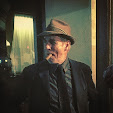There's a four panel cartoon I saw somewhere. In the first panel we see a husband and wife sitting down in their seats at the theatre. In the second panel the play is under way and the husband is clearly bored and unhappy. In the next panel he's even more distressed and looks positively miserable. In the final panel the play is over and the wife asks him "What part of Noh don't you understand?"
Well you could fill a library with the things I don't know or understand about Noh Theatre but after catching the Umewaka Kannekai performance at the Kanze Noh-Gakudo in Shibuya, I have a few impressions.
Yes, I was bored at points in the three plus hours in which they performed two Noh plays; Yoshino Ten nin (Celestial Nymph in Yoshino Mountain) and Utu (The Bird Hunter) plus a Kyogen play; Suhajikami. (Vinegar and Pepper)
There were also points at which I was fascinated.
But here's the thing.
There were also moments when I was bored and fascinated at the same time.
For example: Noh challenges the viewer to reassess the audience/performer relationship. At first I thought it was a mistake but the houselights never came down.
So the actors can see you.
That magic moment so essential in Western theatre, when the audience sets aside their programs and nestles in the darkness and the curtain rises or the stage lights come up just never happens in Noh. The lighting never changes at all from beginning to end.
Boring.
Yet Fascinating.
In fact the actors who are masked- there are two in each play. The shite or "one who acts" and the waki or "one who watches" see more of you than you do of them. At least if you're talking about faces. But the Noh actor is also a dancer. And a singer.
As a dancer, the precision the Noh actor must attain is astounding. The first thing I noticed was footwork. Probably since I'm working on my own footwork in Iaido, Ashi Sabaki we call it, I fixated on the achingly slow and infinitesimally prescribed walking and turning they do that must take countless hours of practice. The nano adjustments they are making with their center of gravity with each step as they slide the souls of their tabi covered feet across the polished wood of the hanamichi must be maddening to master.
Again; boring- but fascinating.
And the single, devastatingly economical gesture they make to indicate grief is like an ancient, elemental sign language.
The actors and musicians all carry fans, tucked into their obi between the second and third wrap- exactly where we place our katana in Iaido. In fact the fan is the equivalent of the actors' sword.
The masks themselves are smaller than the actor's actual faces which suggests that all that life force must somehow be compressed into the character expressed by the mask, squeezed into a finite area like commuters at rush hour on the Maranouchi train at Ikebukuro station.
The music and singing is also challenging.
Primarily two drums and a bamboo flute, the rhythms are not based on the Western 4/4 beat inspired by the hoofbeats of horses but rather on the random dissonance of the natural sounds of raindrops falling from the eaves of a temple or cedars creaking in the wind.
The drummers accompany themselves with various moans and yelps, like the sound of mill wheels turning or crows cawing derisively at the foibles of Man.
The masked actors chant their lines and they better be correct; I saw lots of old ladies reading along with the text in their laps during the show.
The stories themselves usually involve strangers meeting at an unfamiliar place, where one of them turns out not to be what is initially presented, and then he "disappears" which is represented by him slowly walking off stage. In Noh, that is disappearing. There seems to be no moral. No judgment. Just "This odd thing happened." That's it.
Two moments stand out to me. In Utu (The Bird Hunter) The actor playing the ghost of the bird hunter makes a gesture as if to strike a bird resting on a branch. The invisible bird flies away. The masked actor "watches" the bird escape and fly off. There is such longing and remorse in his expression, the moment is so unfulfilled, I felt emotion well up in me so suddenly and so surprisingly. A second earlier I was bored out of my gourd, and now I was near tears. And just as suddenly, it was gone. Was it me, or was this oh so subtle art revealing it's power?
Here was clear evidence of a vast collaboration at work. The musicians, the actor, the sculptor of the mask, the weaver of the exquisite costume, the carpenter who built the temple-like stage, all of them conspiring to express this enigmatic moment. And then it was gone. Transient as a wisp of steam or a sparrow alighting from a branch.
The other moment was at the end of each play. Once the performer has chanted the last line the musicians stop. The actors go offstage walking in a slow precession. The musicians follow. There is no curtain call. No light change. No unmasking. Nothing. Polite applause from the audience as they exit. It's as if to say "That's it. We're finished. We told you the story we came to tell. This odd thing happened. Wasn't it boring? Wasn't it fascinating?"
Yes and Noh.
Friday, November 21, 2008
Subscribe to:
Post Comments (Atom)

1 comment:
Hey, thanks for this. I've been researching Noh for a book I'm writing and it's hard to find this type of review.
Post a Comment